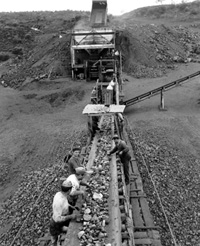|
Other mining continued
Manganese
The presence of manganese ores in the East Pilbara and Peak Hill areas was noted by Government geologists before 1920. However, although small parcels of manganese
ore were produced from the Peak Hill area in the 1920s, systematic production began there only after 1948.
Limited production, mainly from the Horseshoe deposit, continued until 1971, peaking between 1965 and 1970. Exports were initially restricted because manganese was
indispensable for steel making, and was viewed as a strategic mineral. Production from mines in the East Pilbara began in 1954. Their output peaked between 1966 and 1972 at the rate of over 100,000 tonnes a year.
Production of manganese in both areas was from small, high-grade surface deposits.
Operations ceased in the 1970s due to depletion of high grade ore, high transport costs, and because the availability of cheap ore from the Northern Territory.
Production from dumps around the deposits at Woodie Woodie began in 1989 with Portman Mining re-opening the deposits themselves in 1990 in an industry worth 13 million dollars in 1999.
Nickel
Exploration for nickel began in Western Australia in 1955 with the International Nickel
Company that discovered a large but uneconomic deposit on the border with South Australia. Interest in nickel waned until 1964 when a Western Mining Corporation
exploration team was told nickel had been identified in rocks around Kambalda, south of Kalgoorlie. Nickel sulphides were subsequently discovered at depth in 1966 and production began the following year.
This discovery spurred extensive exploration for nickel, concentrated mainly in a belt
between Norseman and Wiluna. With nickel in short supply prices for the metal were high, exploration took off and Western Australia experienced a nickel boom on the
stock market. The Nepean ore body to the south west of Kalgoorlie was discovered in 1967 and production began there in 1970. Later in 1967, nickel deposits were
discovered around Widgiemooltha, south of Kambalda, but mining was delayed until 1973. Exploration further afield discovered the Windarra deposits near Laverton in
1969, Mt Keith (1969), Yakabindie (1970) and Agnew/Leinster (1971) deposits, and the Forrestania deposits in 1971. Although the Agnew operation closed in 1986, it
was bought by Western Mining in 1988 and re-opened the following year. By the late 1990s it accounted for 44% of Western Australian nickel concentrate production in an industry worth 1,135 million dollars in 1999.
In 1970 a nickel refinery was established at Kwinana, followed by a smelter near Kalgoorlie in 1973. In 1979 it was expanded to accommodate production from
Agnew. By the 1990s production had been expanded at Leinster to sustain capacity at Kambalda, and to expand the capacity of the smelter at Kalgoorlie and the refinery
at Kwinana by 50%. The extra smelter and refinery capacity became operational in 1994. Along with the move to underground operations at Forrestania, these measures
have combined to make Western Australia one of the lowest cost producers in the world.
|
|




